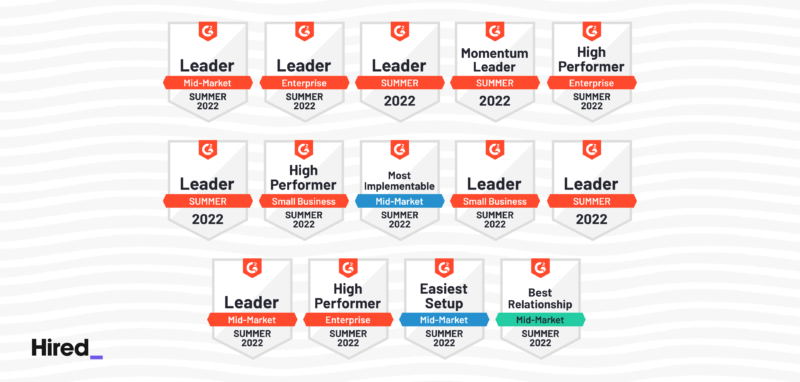
Hired Releases 2021 Report on Wage Gap and Workplace Discrimination
While the wage gap is narrowing, Hired data reveals unequal pay and discrimination remain prevalent for underrepresented talent in tech
New York, May 19, 2021 — Men were offered higher salaries than women for the same job title at the same company 59% of the time in 2020, compared to 65% in 2019, according to a new report by Hired, the leading AI-driven hiring marketplace that matches tech and sales talent with top companies. The fifth annual report analyzes wage inequality and discrimination based on gender, sexuality, race, age, and non-traditional educational backgrounds in the tech industry.
The Hired 2021 Impact Report – Wage Inequality in the Workplace is based on data from Hired’s network of over 10,000 participating companies and more than 245,000 job seekers, as well as survey results from over 2,000 tech employees. Prioritizing DE&I is no longer an option for forward-thinking companies. Over 83% of survey respondents said that it was important that their employer takes meaningful steps to promote diversity and inclusion.
UPDATE: 2022 Report
Every year, Hired’s report finds that there is a strong link between the wage gap and the salary expectations of disadvantaged groups. The 2021 report found that companies offered women 3% less on average than men for the same roles in 2020, compared to 4% in 2019. At the same time, the average expectation gap decreased from 6% in 2019 to 3% in 2020, showing a clear correlation.
“We continue to see that underrepresented talent who are paid less also expect lower salaries than their white, male counterparts – even if they have the same experience. Our data shows that offering everyone visibility into what a fair wage truly is would make a meaningful impact towards narrowing the wage gap,” said Josh Brenner, CEO of Hired. “We hope this report can give employers the confidence that increasing salary transparency and narrowing the wage gap is the right thing to do – for both their team and business. Our vision is to build a world where hiring is equitable, efficient, and transparent, and with the right commitment from businesses, that goal is achievable.”
Additional key findings from the report include:
- Certain markets have more work to do than others when it comes to narrowing the gender wage gap but all showed women are consistently offered less than men. In London, the gender wage gap remains at 10%, whereas it’s down to 5% in the San Francisco Bay Area. Most markets are in between these extremes, with Chicago and Boston at 8%, New York and Toronto at 7% and Seattle at 6%.
- Black candidates saw wages that were 4% lower than the baseline in 2020 vs. a gap of 5% in 2019. By contrast, Asian candidates saw no change, receiving offers that were 1% lower in 2020 and 2019.
- White employees are less likely to have discovered they were being paid less than a colleague in the same role. On the occasions where they do discover a discrepancy, they receive a salary increase after surfacing the discrepancy 28% of the time. When Black or Hispanic employees surface pay discrepancies, they receive salary increases 20% and 15% of the time, respectively.
- Race contributes significantly to the expectation gap, as low wage expectations are most prevalent in minority women compared to white women or minority men. For example, Black women expect salaries that are 10% lower than those of their white male counterparts.
- Younger employees are more likely to ask for, and receive, more equal wages than in past generations – a trend that has continued YOY. And, when entry-level employees are paid more equitably, it increases their chances of being paid fairly throughout their careers. Continuing to increase wage transparency and reducing the expectation gap for entry-level employees could have a profound, long-term impact on wage inequality as a whole.
- Tech candidates who are either self-taught or learn through a bootcamp are getting more interviews than those with traditional degrees but expect salaries that are up to 6% lower than the norm – and are paid less as a result.
- The best way for businesses to show candidates that they are serious about creating an equal workplace is by increasing wage transparency, hiring a diverse range of candidates, and increasing the diversity of their senior leadership team. Over 70% of candidates believe employers need to increase salary transparency across their company.
- Salary transparency is a retention problem. Two-thirds of tech employees report learning they were being paid less than their counterparts for the same work, and from those, over 40% look for new positions. If companies chose to promote transparency earlier on, they’d be saving costs in the long term due to higher employee fulfillment and increased retention.
- Based on survey results, 36% of men report experiencing discrimination in the hiring process compared to 57% of women.
To access the full Hired 2021 Impact Report – Wage Inequality in the Workplace, visit: https://hired.com/h/wage-inequality-report/2021/
About Hired
Hired is the largest AI-driven marketplace that matches tech and sales talent with the world’s most innovative companies. Backed by the world’s leading talent advisory and solutions company, The Adecco Group, Hired combines intelligent job matching with unbiased career counseling to help people find a job they love and reach their full potential. By providing accurate, real-time information, access to equal opportunity, efficiency, and transparency, the Hired platform serves as the backbone for hiring managers, recruiters, and C-level executives to surface the best matching talent and build ambitious, diverse teams. Hired is committed to building equity in the hiring process through a more representative talent pool, using bias reduction features, customized assessments, and salary bias alerts to help remove unconscious bias when hiring. For more information, visit hired.com.
Media Contact
Gravitate PR for Hired
hired@gravitatepr.com
Related blog posts

G2 Honors Hired with 14 Awards in Job Search Sites, Recruiting Automation, & Diversity Recruiting for Summer 2022
Hired is excited to announce multiple recognitions from G2 in the 2022 Best Software Awards. G2 is...

Hired Releases 2023 State of Software Engineers Report
2022 layoffs impacted demand and salaries for junior and nontraditional engineering candidates;...

Hired Releases 2023 UK State of Software Engineers Data
Report includes proprietary and survey data from employers and UK engineers Key...

Hired’s 2022 List of Top Employers Winning Tech Talent
Companies scored across equity, efficiency, and transparency in hiring processes based on Hired’s...

What is Hired.com?
What is Hired or Hired.com? When employers or jobseekers ask, ‘What is...

What Top Tech Employers Do Differently: New Hiring Data to Win in 2023
Top Tech Recruiting & Hiring Benchmarks: 2022 Data for TA & Hiring Managers To better...
